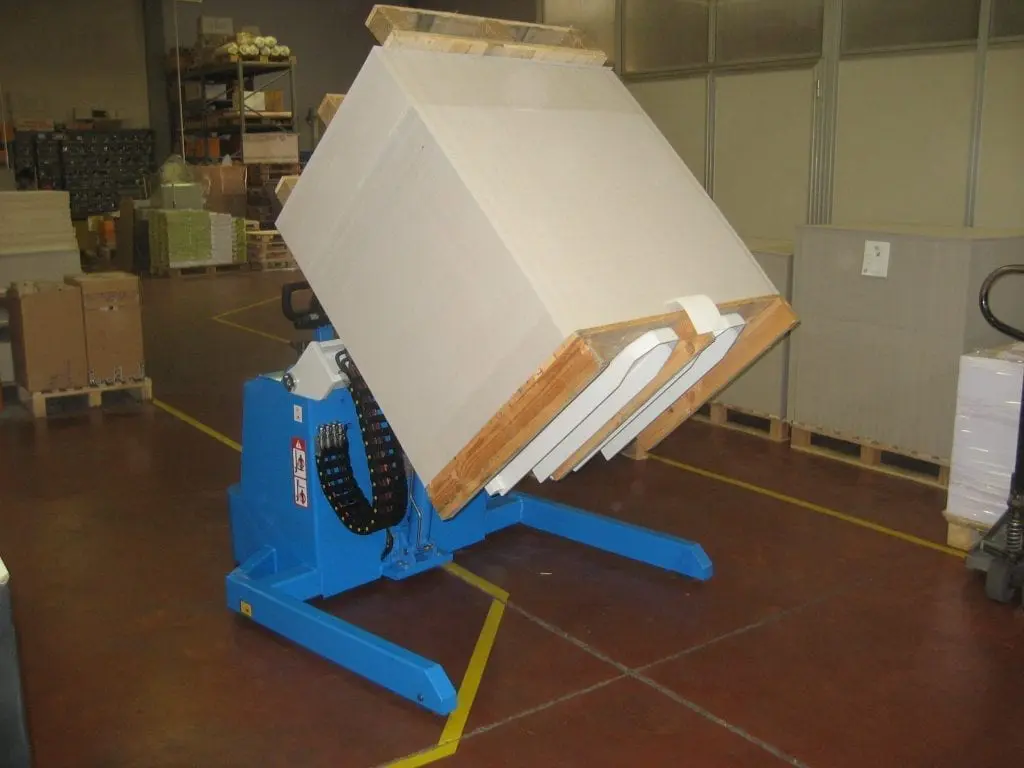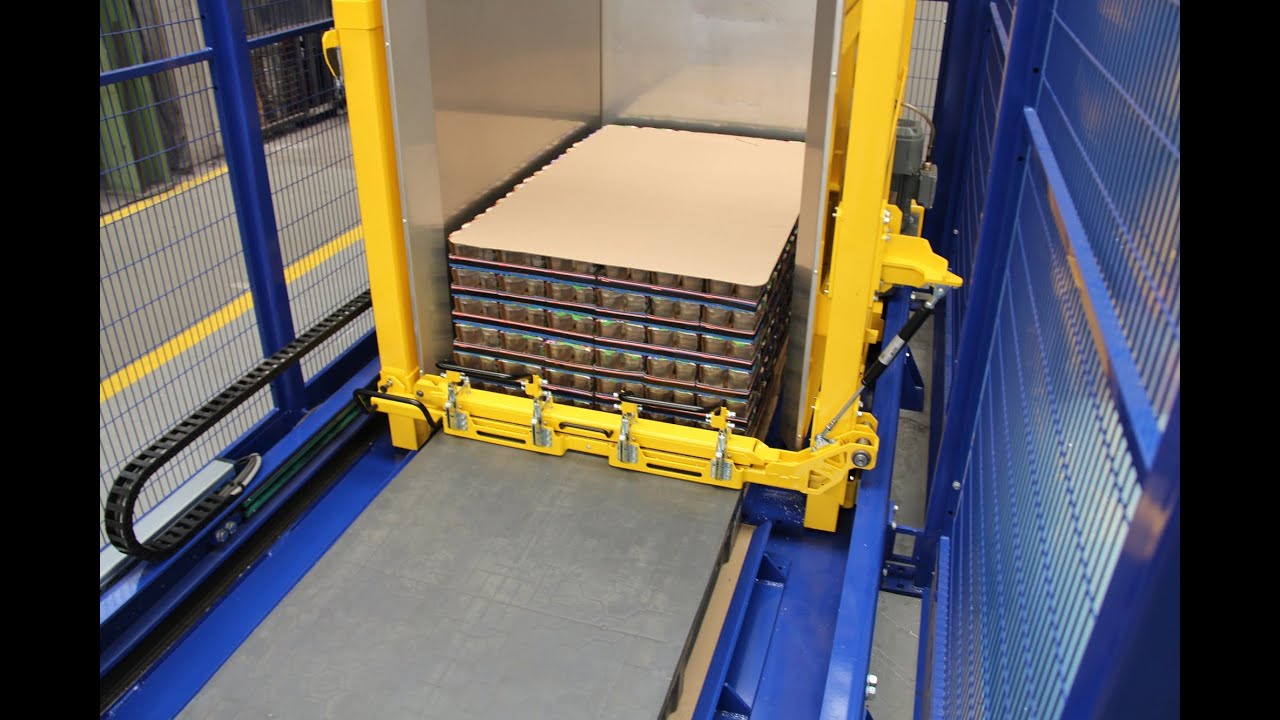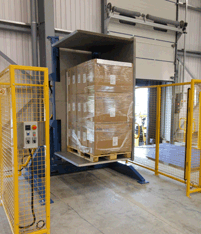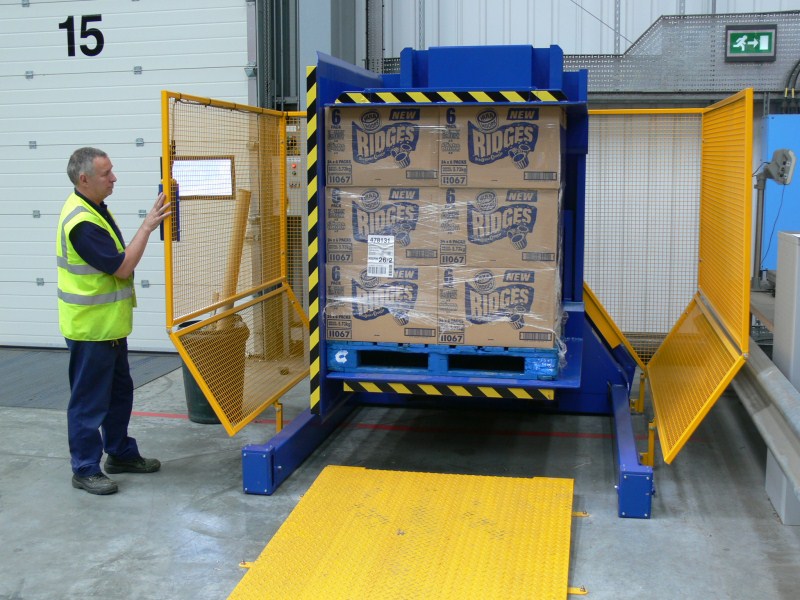Cutting Downtime in South Korea: How Pallet Changing Machines Help
Downtime is a constant battle in manufacturing. Every minute your line is stopped, you are losing money. This is especially true in the high-speed, high-volume industries of South Korea. A major cause of these costly delays is often found at the end of the line: manual pallet handling. The process is slow, requires multiple workers, and carries a high risk of product damage or worker injury. It's a persistent bottleneck that silently drains your profits. I've seen this challenge firsthand in many factories, from small operations to large steel mills. The pressure to meet production targets is immense, yet this one manual step can bring everything to a halt. The good news is that there is a straightforward and effective solution. Automated pallet changing machines are designed specifically to eliminate this source of downtime, creating a smoother, faster, and more profitable workflow.
Pallet changing machines help cut downtime in facilities, including those in South Korea, by automating the slow, manual process of transferring goods between pallets. This automation minimizes production stoppages, reduces the labor needed for the task, prevents product damage, and increases overall throughput. By turning a major bottleneck into a streamlined process, these machines directly address the root causes of operational delays and improve line efficiency.

This might sound like a simple fix, but the impact on your operation can be massive. Throughout my career, from my first days as a packing machine engineer to establishing my own factory, I've dedicated myself to solving these kinds of efficiency problems. You are likely asking yourself how this technology works and if it can truly make a difference in your specific plant. Let's dig deeper into the details. I want to show you exactly how pallet changers work and how they can become one of the most valuable assets on your factory floor.
How Can Pallet Changers Reduce Manual Handling?
Your production line might be a model of efficiency, but if the final stage involves workers manually transferring heavy loads from one pallet to another, you have a serious problem. This process is not only slow and physically exhausting, but it is also a constant source of safety risks and potential product damage. Each time a worker has to manually re-stack a load, you risk a strained back, a lost-time incident, or worse. And every time a product is accidentally dropped or damaged, it means scrap, waste, and a potential missed deadline for your customer. You are aiming for maximum uptime, but these manual tasks are constantly eating away at your efficiency metrics. A pallet changer solves this by taking the human risk element completely out of the equation. It is a machine designed to securely handle the entire load and swap the pallet underneath, all without manual intervention.
Pallet changers reduce manual handling by mechanically securing and moving the entire product load to swap the pallet beneath it. The machine uses clamps or pressure plates to hold the product safely in place while it is tilted, rotated, or pushed. This completely removes the need for workers to physically lift, re-stack, or handle individual items, turning a dangerous, multi-person job into a safe, fast, and automated one-person operation.

Dive Deeper: The True Cost of Manual vs. Automated Handling
When you analyze manual pallet swapping, you must look beyond just the labor costs. The true cost is much higher and impacts your business in several ways. An automated pallet changer, on the other hand, offers benefits that ripple through your entire operation.
The Hidden Costs of Manual Pallet Swapping
Manual handling is expensive, but the costs are not always obvious on a balance sheet. You have direct labor costs, of course. But you also have indirect costs that can be far greater. These include the financial impact of workplace injuries, the cost of damaged or scrapped products, and the massive opportunity cost of production downtime. Every minute spent manually handling a pallet is a minute your production line is not running at full capacity. For a steel mill owner like my client, Javier, whose aging equipment already presents challenges, minimizing these unplanned stops is critical to maintaining profitability.
| Cost Factor | Manual Handling Impact | Automated Handling Solution |
|---|---|---|
| Labor Cost | Requires 2-3 workers per station, per shift. | Requires 1 operator to oversee the process. |
| Safety Risk | High risk of back injuries, strains, and slips. | Eliminates physical lifting, drastically reducing injury risk. |
| Product Damage | Risk of dropping or crushing items during transfer. | Secure clamping system protects the load at all times. |
| Efficiency | Slow process (5-10 minutes per pallet). | Fast process (60-90 seconds per pallet). |
| Operational Downtime | Creates a major bottleneck, stopping the line. | Can be integrated inline for continuous flow. |
How a Pallet Changer Works: The Process
Understanding the machine's operation shows why it is so effective. While designs vary, the core process is simple and reliable.
- Load Entry: A full pallet is moved into the machine, usually by a forklift or an integrated conveyor.
- Clamping: The machine uses side plates or a top plate to apply gentle but firm pressure, securing the entire load. This pressure is often adjustable to handle everything from sturdy steel coils to delicate boxes.
- Transfer: This is where different machine types vary.
- Pallet Inverter: The machine clamps the load and rotates it 180 degrees. The old pallet is now on top and can be easily removed and replaced. The machine then rotates back.
- Pallet Changer: The machine clamps the load and uses a pusher mechanism to slide the entire load from the old pallet onto a new pallet waiting beside it.
- Release and Exit: The clamping plates retract, and the newly palletized load is moved out of the machine, ready for shipping or warehousing.
This entire sequence is automated and controlled by a simple interface, turning a difficult manual task into a simple, repeatable, and safe machine process. This frees up your valuable workers to focus on more skilled tasks, supporting a transition to a more digitized and efficient factory floor.
What Are the Key Features of a High-Efficiency Pallet Changer?
You are sold on the concept, but you know that not all equipment is built to the same standard. Investing in the wrong pallet changer could be a costly mistake. You might end up with a machine that is unreliable, too slow for your production line, or incapable of handling your specific products without causing damage. Imagine making a significant capital investment only to find it creates a new set of problems. It would be a frustrating setback, especially when you are under pressure to lower operational costs and improve efficiency. The solution is to know exactly what to look for. A high-quality, efficient pallet changer is defined by a set of key features that ensure performance, safety, and a long service life.
Key features of a high-efficiency pallet changer include a robust clamping system with adjustable pressure to protect products, a fast cycle time to keep up with production, versatile handling capabilities for different load sizes, comprehensive safety systems like light curtains and physical guarding, and a simple, user-friendly control panel. These features ensure the machine is a reliable and productive asset.

Dive Deeper: Anatomy of a Reliable Machine
When I consult with clients like Javier, who has an engineering background and a deep understanding of machinery, we focus on the details that separate a good machine from a great one. For a pallet changer, these details fall into two categories: the mechanical build and the control systems.
Must-Have Mechanical Features
The physical construction of the machine determines its durability and capability. A machine destined for a tough environment like a steel plant or a busy logistics hub in South Korea needs to be built to last.
- Heavy-Duty Frame: The foundation of the machine must be solid. Look for a frame constructed from heavy-gauge steel, welded for maximum rigidity. A flimsy frame will flex under heavy loads, leading to premature wear and potential failure.
- Powerful Clamping System: This is the heart of the machine. The system should be powerful enough to hold your heaviest loads securely. Hydraulic systems typically offer the most power and are ideal for very heavy products like steel or paper rolls. The most critical feature here is adjustable clamping pressure. You need to be able to dial down the pressure for delicate goods and increase it for heavy, stable loads. This prevents product damage.
- Quality Components: The motors, gearboxes, chains, and hydraulic or pneumatic components should come from reputable manufacturers. Using high-quality components means higher reliability, less maintenance, and a longer service life.
Essential Control and Safety Systems
The "brains" and "senses" of the machine are just as important as its muscle. Modern control systems make the machine smart, safe, and easy to use.
- Reliable PLC Controls: The Programmable Logic Controller (PLC) is the machine's brain. Using industry-standard PLCs from brands like Siemens or Allen-Bradley ensures reliability and makes troubleshooting and integration easier.
- Intuitive HMI: The Human-Machine Interface (HMI) is the touch screen or control panel. It should be simple, with clear graphics and easy-to-understand commands. Your operator should be able to run the machine with minimal training.
- Comprehensive Safety Features: Safety is non-negotiable. A high-quality machine will have multiple layers of safety. This includes physical safety fencing to prevent access during operation, light curtains that immediately stop the machine if a person or object crosses their path, and clearly marked emergency stop buttons.
| Feature | Its Benefit to Your Operation |
|---|---|
| Adjustable Clamping Pressure | Prevents damage to a wide variety of products. |
| Heavy-Gauge Steel Frame | Ensures long service life and handles heavy loads. |
| Name-Brand PLC/Components | Increases reliability and simplifies maintenance. |
| Light Curtains & Fencing | Protects your workers and ensures regulatory compliance. |
| User-Friendly HMI | Reduces training time and minimizes operator error. |
Focusing on these key features ensures you are investing in a machine that will solve your downtime problem, not create new ones.
How Do Pallet Changers Integrate into Existing Production Lines?
Your factory floor is a carefully organized ecosystem of machines and conveyors. The idea of introducing a new piece of equipment can feel overwhelming. You might worry about where it will fit, how it will connect to your existing line, and how much disruption the installation will cause. A poorly planned integration can create a new bottleneck, defeating the entire purpose of the investment. It could lead to extended shutdowns and a difficult learning period for your team, directly working against your goal of increasing capacity utilization. But it doesn't have to be this way. Modern pallet changers are designed with integration in mind. They can be added to your line as a modular, almost "plug-and-play" solution with minimal disruption.
Pallet changers integrate into existing production lines using powered roller or chain conveyors that automatically feed loads into and out of the machine. They can be installed as an "offline" standalone station served by a forklift, or "inline" to be fully automated. In an inline setup, the machine's control system communicates with the main production line's PLC or MES to operate in perfect sync with upstream and downstream equipment.

Dive Deeper: Choosing the Right Integration Strategy
The key to a successful integration is planning. I remember working with a client in South Korea who manufactured automotive parts. They needed to switch from wooden pallets used in-house to plastic pallets for shipping to their customer. We had to find a way to integrate a pallet changer without stopping their 24/7 operation. The solution depends on your specific layout, throughput, and budget.
Standalone vs. Fully-Inline Integration
You have two primary options for integrating a pallet changer.
- Standalone (Offline) Station: In this setup, the pallet changer is placed in a dedicated area away from the main production line. A forklift driver brings a pallet to the machine, the machine swaps the pallet, and the forklift takes the newly palletized load away. This is the simplest and most flexible option.
- Fully-Inline (Online) Integration: Here, the pallet changer is placed directly within the production line. Conveyors automatically feed loads into the machine, and other conveyors take them away after the pallet is changed. This setup is completely automated and offers the highest throughput.
| Integration Type | Pros | Cons |
|---|---|---|
| Standalone | Lower initial cost, highly flexible, minimal disruption to install. | Requires forklift and operator, lower throughput, can become a bottleneck if volume is high. |
| Fully-Inline | Highest throughput, fully automated, no manual intervention needed. | Higher initial cost, requires more space, installation is more complex. |
The Critical Role of Conveyors and Sensors
For a fully inline system to work, it needs to connect seamlessly with your existing line. This is achieved with conveyors and sensors.
- Conveyors: Powered roller or chain conveyors are used to move the heavy loads into and out of the pallet changer. These must be robust enough to handle your product's weight and size.
- Sensors: This is where the system gets smart. Photo-eye sensors are placed along the conveyor. They detect when a pallet has arrived at the correct position, signaling the pallet changer to begin its cycle. Other sensors confirm that the new pallet is in place and that the exit conveyor is clear. This use of IoT sensors is a key step in any digital transformation journey, providing the real-time data needed for a fully visualized production process.
Connecting to Your Plant's "Brain"
For the ultimate level of integration, the pallet changer’s PLC can be connected to your facility’s Manufacturing Execution System (MES) or Enterprise Resource Planning (ERP) system. This connection allows the pallet changer to become part of your smart factory. It can receive commands from your scheduling platform and send back data on cycle times, number of pallets changed, and any operational faults. This provides management with a complete, real-time view of the end-of-line process, which is essential for achieving goals like 95% capacity utilization.
What Is the ROI on a Pallet Changing Machine in a Steel Plant?
As a business owner or CEO, you scrutinize every major purchase. A pallet changing machine represents a significant capital investment, and you need to be certain that the numbers add up. The most important question is: what is the Return on Investment (ROI)? You need a clear, data-driven justification for the expense. With constant pressure from things like fluctuating energy costs and unstable market demand, you cannot afford to invest in equipment that does not deliver a fast and measurable financial return. The great news is that when you analyze the cost savings from a pallet changer, the ROI is often much faster than people expect. By calculating the savings in labor, safety, product damage, and efficiency, you can often justify the investment with a payback period of less than two years.
The ROI on a pallet changing machine in a steel plant is calculated by dividing the total investment cost by the total annual savings. These savings are generated from several key areas: reduced direct labor costs from reassigning workers, elimination of costs associated with product damage during manual handling, lower insurance premiums due to improved safety, and increased revenue from higher throughput and less downtime.

Dive Deeper: Calculating Your Return
For a pragmatic leader like Javier, who demands a strict feasibility analysis for every investment, the calculation needs to be clear and conservative. Let's break down how to build a compelling business case for a pallet changer, focusing on the real-world numbers you would see in a steel plant or a large manufacturing facility.
Breaking Down the Cost Savings
The annual savings come from several sources. To calculate your ROI, you need to quantify each one.
- Labor Savings: This is the easiest to calculate. If manual handling requires two workers and the process runs for three shifts, you are paying for six full-time positions just to swap pallets. An automated system requires only one operator to supervise. The savings are the wages and benefits of the reassigned workers.
- Product Damage Reduction: In a steel plant, products like coils or wire are high-value. Dropping or damaging just one can cost thousands of dollars. Even a conservative estimate of reducing handling-related damage by 90% can lead to significant annual savings.
- Downtime Reduction & Throughput Increase: This is a huge factor. A manual swap can take 5-10 minutes, stopping your line. An automated cycle takes about 90 seconds. If your line produces $5,000 worth of product per hour, saving just one hour of downtime per day adds up to over $1.5 million in a year.
- Safety and Insurance Savings: Fewer workplace injuries lead to lower workers' compensation insurance premiums and eliminate the costs associated with lost-time incidents.
A Sample ROI Calculation
Let's use a hypothetical example for a steel facility operating 24/7.
| Investment & Savings | Calculation | Amount |
|---|---|---|
| A. Initial Investment | Cost of Pallet Changer + Installation | $85,000 |
| B. Annual Labor Savings | 5 workers * $45,000/year (salary + benefits) | $225,000 |
| C. Annual Damage Savings | 1% of $10M in handled goods | $100,000 |
| D. Annual Throughput Gain | 30 min/day saved 300 days $3,000/hr value | $45,000 |
| E. Total Annual Savings | B + C + D | $370,000 |
| Payback Period | A / E | 0.23 Years (approx. 3 months) |
Note: These numbers are illustrative. Your actual savings will depend on your specific labor costs, product value, and production rates.
Even with much more conservative estimates, the payback period for this equipment is typically between 12 and 24 months.
Beyond the Numbers: The Strategic Value
The ROI calculation is compelling, but the strategic benefits are just as important for a forward-thinking leader. This investment is a step toward your digital transformation goals. It improves workplace safety, boosting employee morale. It increases your operational flexibility, allowing you to easily meet different customer packaging requirements. Investing in this technology sends a clear message to your employees and customers that you are committed to building a modern, efficient, and safe operation for the future.
Conclusion
A pallet changer is more than a machine. It is a strategic investment in efficiency, safety, and future growth. It directly tackles downtime, cutting costs and boosting your bottom line.




